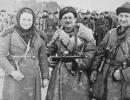Download presentation War of Independence. Presentation - the War of Independence and the formation of the United States. "System of checks and balances"
The American Revolutionary War was a war between Great Britain and the Loyalists (those loyal to the legitimate government of the British Crown) on the one hand, and the revolutionaries of the 13 English colonies (patriots) on the other, who declared their independence from Great Britain as an independent union state in 1776.

BACKGROUND OF THE WAR In 1765, the English government passed through Parliament the Stamp Act, according to which all trade and other civil documents were subject to a stamp duty. At the same time, it was decided to station 10 thousand British troops in America. With the obligation of the Americans to provide him with housing, certain food products and pieces of furniture for the comfort of the soldiers. The Stamp Act was openly unfair to Americans. So, for example, to obtain the rights of a notary in England you had to pay 2 pounds sterling, and in America 10. In addition, this was the first law on taxes that were intended directly for England, that is, it was beneficial only to England. Prior to this, taxes were used to develop the infrastructure of trade and industry and were largely understandable to the population.

In Massachusetts, the famous phrase attributed to J. Otis was uttered, and became the motto "Taxes without representation is tyranny", in the struggle: turned into the shorter slogan "No taxes without representation." The Virginia Assembly saw in the stamp act a clear desire to reduce the freedom of Americans. In the same year, 1765, the “Congress Against the Stamp Fee,” which represented most of the colonies, met in New York; he drafted the Declaration of Colonial Rights. Organizations calling themselves the Sons of Liberty began to appear in almost all colonies. They burned effigies and houses of English officials. Among the leaders of the Sons of Liberty was John Adams, one of the founding fathers of the United States and the future second president of the country.

Boston Tea Party In 1773, the East India Company received the right to duty-free import of tea. This led to the ruin of many merchants. The colonists refused to buy tea. In Boston, the governor decided to unload the tea. Members of the Sons of Liberty, disguised as Indians, boarded English ships and threw 45 tons of tea overboard.

The Congress was called the First Continental Congress, and was attended by George Washington, Samuel and John Adams and other prominent American figures. The First Continental Congress reviewed laws that violated the interests of the colonies. Congress developed a petition to the king and an appeal to the English people; these documents recognized America's connection with the mother country, but insisted on the abolition of the last parliamentary acts regarding the colonies and demanded justice, threatening otherwise a cessation of trade with England. A “Declaration of Rights and Grievances” was issued, which contained a statement of the rights of the American colonies to “life, liberty and property”, and also protested against the customs and tax policies of the mother country. Congress declared a boycott of British goods until the complete abolition of discriminatory acts. After the Boston incident, which banned legislative assemblies, they, however, continued to meet, and on September 5, 1774, a completely illegal Congress of Representatives from 12 colonies (55 representatives from all American colonies of Great Britain, with the exception of Georgia), elected by legislative assemblies, opened in Philadelphia. First Continental Congress

The battles of Lexington and Concord were the first armed clashes during the American Revolutionary War. The first shots of the battle were fired at dawn on April 19, 1775 in Lexington. The regular army outnumbered the militia, the latter retreated, and British regulars entered Concord. At Concord's North Bridge, about 500 militia fought and defeated three companies of the royal army. The numerically superior regular troops were forced to retreat. More militia soon arrived, causing heavy casualties among the regular troops and forcing them to retreat to Boston. The increased numbers of the militia blocked the narrow strip of land leading to Charleston and Boston, thereby beginning the so-called Siege of Boston. Ralph Waldo Emerson, in his “Hymn of Concord,” described the Patriots’ first shot at North Bridge as “the shots heard round the world.”

Representatives from all 13 states attended the convention. Decisions were made on the organization of the armed forces and on the appointment of General D. Washington as commander in chief of the American army. In May 1776, the colonies were asked to organize completely independent authorities, and a resolution was adopted that “all power emanating from England should be completely eliminated.” Second Continental Congress (May 10, March 1781) Despite the restrained attitude of a number of states towards the idea of independence, in July 1776 Congress adopted the document fundamental for the new state - the “Declaration of Independence”. It proclaimed a break with the metropolis and self-determination of the colonies in the new state formation of the American nation

Thomas Jefferson Author of the Declaration of Independence Third President of the United States The Declaration of Independence, the founding document of the American Revolution, adopted by the Continental Congress on July 4, 1776, declaring the separation of its 13 North American colonies from Great Britain. This was the first document in history that proclaimed the principle of sovereignty as the basis of government. Its precise formulations affirmed the people’s right to revolt and overthrow a despotic government, proclaimed the basic ideas of democracy - the equality of people, their “inalienable rights, including the right to life, liberty and the pursuit of happiness.” The Declaration became not only the “birth certificate” of the new state, but also a recognized monument of American literature: Jefferson managed to express well-known principles and ideas in excellent language, in a concise and accessible form. Declaration of Independence

Signing of the Declaration of Independence painting by John Trumbull Education of the United States The first President of the United States, George Washington, spoke of the American flag: The stars we took from the heavens, red is the color of our homeland, the white stripes that divide it mean that we have separated from it; these white stripes will go down in history as a symbol of freedom.

Progress of the war After an unsuccessful attempt to capture the city of Charleston (South Carolina), the British transferred their forces to the north. Since July 1776, William Howe won a series of victories: he captured New York and inflicted several significant blows on the troops of Washington, who had to retreat across the Delaware River. Washington did not have much talent as a commander, and his men could not compare with the regular English forces, but this strong people never gave up, and besides, the British, who were fighting on foreign territory, began to have problems with supplies and replenishment. Washington boosted the morale of his troops by recrossing the Delaware River and surprising an enemy garrison of nearly a thousand on Christmas night 1776. However, the following year success was again on the side of General Howe, who captured Philadelphia. Washington's army was greatly depleted after that frosty winter.

The British were let down by hopelessly poor planning. While Howe's corps marched on Philadelphia, another general, John Burgoyne, hoping to link up with him north of New York, led his army from Canada towards the city of Albany through difficult terrain, falling into rebel ambushes. As a result, the British were surrounded by superior enemy forces and laid down their arms near Saratoga. Inspired by the rebels' successes, the French entered the war on the American side. The Spaniards and Dutch soon followed suit. The British, who had lost command of the sea, had to fight on several fronts. George III was ready to make concessions, but the Americans only needed independence. Progress of the war

The surrender of the British at Yorktown, a thousand-strong American-French army (Lafayette, Marquis Rochambeau, George Washington) forced the 9,000-strong army of British General Cornwallis to capitulate on October 19 at Yorktown in Virginia, after the French fleet of Admiral de Grasse (28 ships) cut off British troops from the metropolis on September 5. The defeat at Yorktown was a severe blow for England, predetermining the outcome of the war.

Results of the war Having lost troops in North America, Great Britain sat down at the negotiating table in Paris. On November 30, 1782, a truce was concluded, and on September 3, 1783, Great Britain recognized the independence of the United States. The independent American government gave Florida to Spain, renounced rights to the west bank of the Mississippi to France, and recognized British rights to Canada. The support of the American separatist republicans turned into its own revolution for France, in which “American” veterans took an active part.

US Constitution The US Constitution was adopted on September 17, 1787 at the Constitutional Convention in Philadelphia and subsequently ratified by all thirteen then existing American states. It is considered the world's first constitution in the modern sense. It consists of seven articles; during the life of the Constitution, twenty-seven amendments were adopted, which are its integral part. The inspiration for the creation of the Constitution was George Madison, one of the Founding Fathers.

Revolutionary War

New history, 7th grade
"The War of Independence. Creation of the United States of America"
Tikhonova G.I., history teacher

Lesson plan:
1. The beginning of the war for freedom and justice.
4. Successful diplomacy. End of the war.
5. Results and significance of the War of Independence.
6. The need to adopt a Constitution.
7. US Constitution.

In 1774, the Continental Council met in Philadelphia
Congress that adopted the Declaration

Let's write down the definitions:
Congress is a meeting on issues of international importance
Declaration is an official document containing important provisions

The armed struggle began on April 19, 1775. Thus began the War of Independence. The creation of a regular army was entrusted to a wealthy Virginia planter George Washington

Beginning of the War of Independence
Two camps:
warring
Patriots -
Loyalists -
supporters
independence
supporters of the king

US Declaration of Independence
July 4, 1776 Congress in Philadelphia adopted the Declaration of Separation from England. It proclaimed the creation of the independent state of the United States of America (USA).

US Declaration of Independence
Creator: Thomas Jefferson


The end and results of the war:
Allies
France
Holland
Spain
Russia

The end and results of the war:
In 1781 the main British forces surrendered
near Yorktown

The end and results of the war:
In 1783, an equal peace treaty was signed between the USA and Great Britain, in which England recognized the independence of the United States.

Results of the war:
1) destruction of enterprises in the development of industry and trade;
2) space for free competition within the country is open;
3) freedom to dispose of property
4) but slavery persisted

Reasons for adopting the Constitution:
1) decline of the economy
2) lack of funds to overcome economic chaos
3) the need to create a strong central government
4) ruin of farmers
5) poverty
6) uprisings of the farming poor

US Constitution:
IN May 1787 In Philadelphia, a special meeting of state representatives drafted the US Constitution.

Homework:
Paragraph 24, task 3 in writing
Test yourself 3. In what year was the first English settlement in North America founded? A d. B d. C d. D g.




Test yourself 9. Indicate the reasons for the conflict between the metropolis and the colonies: A. Restricted free trade B. Ban on the production of industrial machines in the colonies C. Ban on opening factories D. Introduction of stamp duty E. There was no representation of the colonies in the English Parliament

The Beginning of the Revolutionary War In the winter of 1774, the colonists began to arm themselves. They convened the Continental Congress, which became the government. In June 1775, a decision was made to form an army, headed by George Washington. This led to the actual unification of the colonies to fight the king. Washington is a hero. Engraving from the 19th century.

The beginning of the War of Independence The country was divided into two camps: patriots and loyalists, supporters of independence, defenders of independence, the “legitimate” power of the colonies of the English king and the English parliament. Representatives of which social groups were included in these two camps?




Declaration of Independence The Declaration of Independence proclaimed the creation of an independent state - the United States of America (USA) The principle of popular sovereignty - power must come from the people and the right of the people to overthrow the government that violates their rights Equality of people Inalienable human rights - life, liberty, the pursuit of happiness

Military operations in In the winter, the Congress army, which still had little resemblance to a regular army, experienced great difficulties in supplies and weapons. Under the influence of successive defeats, the army lost its morale. It decreased from 34 thousand to 4 thousand people. The colonists were poorly armed and poorly dressed, and there was not enough ammunition. Many did not want to serve in the army.

Military operations in - confiscation of land and its sale in small plots - allowed to settle beyond the Allegheny Mountains - abolition of land rental payments -T. Jefferson proposed that all poor people be given land from the Western Land Fund.

Military actions in In 1775, defeat at Lexington, then at Bankershill; In January 1777, D. Washington defeated the British at Princeton; On October 19, 1777, the British army was surrounded at Saratoga; In the fall of 1781, American-French troops near Yorktown (Virginia) defeated the British. In 1783, a peace treaty was signed, according to which the former English colonies in New England were recognized as independent.

Military operations in End of the war. Europe declared recognition of the United States. This was done by France, Spain and the Netherlands. They became allies of the Americans. England turned to Russia for help, but it took a position of “armed neutrality” and announced US support.

Military operations in End of the war. Marquis Gilbert de Lafayette () a supporter of the rebels, equipped and armed the division entrusted to him with his own money. His exploits became known in France. Voltaire called Lafayette "the hero of the New World." General Lafayette Unknown artist 18th century.

Results and significance of the War of Independence Nature of the war National liberation - an end to dependence on England Revolution - radical changes (established a republican system, freedom of enterprise, private property) But slavery remained in the southern states, the expulsion of Indians from the lands continued, the life of the poor remained difficult


Constitution of 1787 Legislative branch - US Congress Upper house - Lower house - Senate House of Representatives 2 representatives the number of representatives from each state depended on the number of residents of the state - Appointed to the highest posts - discussed bills - In charge of foreign policy - approved the budget - Could judge the highest states -x - approved taxes for employees (even the president) - impeachment


“Bill of Rights” – 10 Amendments to the Constitution Freedom of speech, freedom of religion, freedom of the press, freedom of assembly, the right to petition The right to keep and bear arms Prohibition of placing soldiers in private homes without the owner’s consent Prohibition of arbitrary searches and seizures Guarantees of due process in criminal cases, prohibition of repeated prosecution for the same offense, right not to incriminate oneself, guarantees during requisitions Rights of the accused, including the right to a jury trial Right to a jury trial in civil cases Prohibition of excessive bail and fines, cruel and unusual punishment List of rights in the Constitution shall not be construed as derogating from other rights. Powers which the Constitution does not expressly assign to the United States are reserved to the states and citizens.







